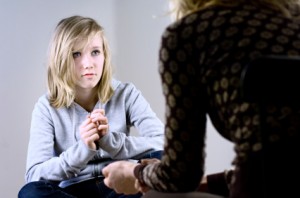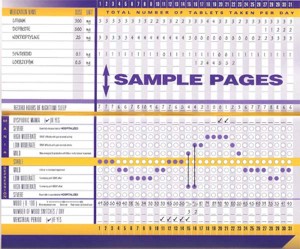Dialectical Behavior Therapy Effective for Adolescents with Bipolar Disorder
As we posted yesterday, therapeutic approaches appear necessary for childhood-onset bipolar disorder. In a poster at the Pediatric Bipolar Conference in Cambridge, Massachusetts in March, Tina Goldstein of Western Psychiatric Institute in Pittsburgh presented an open study indicating that dialectical behavior therapy (DBT) was effective for adolescents with bipolar disorder. This is the second study that has produced these results. In DBT, patients are taught coping skills and mindfulness in order to break the cycle of responding to dysregulated emotions with problematic behaviors.
Psychotherapy Necessary for Bipolar Disorder and Severe Mood Dysregulation in Children
 Dr. Janet Wozniak of Massachusetts General Hospital initiated a survey, both at MGH and in the field, to ascertain practitioners’ experience with individual and family psychotherapeutic and educational approaches to childhood-onset bipolar illness. These types of approaches appear fundamental to treating children or families in which there is bipolar illness.
Dr. Janet Wozniak of Massachusetts General Hospital initiated a survey, both at MGH and in the field, to ascertain practitioners’ experience with individual and family psychotherapeutic and educational approaches to childhood-onset bipolar illness. These types of approaches appear fundamental to treating children or families in which there is bipolar illness.
It was the view of Wozniak, her survey, and many other investigators in attendance at the Pediatric Bipolar Conference in Cambridge, Massachusetts in March that such psychotherapeutic approaches are needed, and often recommended, but the availability of effective treatment and of therapists skilled in administering any of these psychotherapies in children is often lacking.
Lamotrigine for Bipolar Disorder in Kids
Dr. Gagin Joshi of Massachusetts General Hospital reported the results of a study using lamotrigine (Lamictal) for 12 weeks in 39 children with bipolar disorder. Average dose was 160 mg/day and was titrated very slowly because of the increased risk of rash in children treated with lamotrigine compared with adults. Thirty-eight percent of the children achieved remission in mania, and 42% in depression.
In terms of side effects, 28% of individuals experienced gastrointestinal upset; 26% headache, 18% allergy, and 18% dermatological problems which led seven patients to discontinue the trial. However, none of the rashes were severe. This article is to be published in the journal CNS Science and Therapeutics this year.
One Expert’s Personal Treatment Algorithm for Bipolar Disorder in Young Children
EDITOR’S NOTE: Dr. Gagin Joshi of Massachusetts General Hospital, who presented the work on carbamazepine and lamotrigine on page 1 provided us with his own general treatment algorithm for youngsters with bipolar disorder.

Omega-3 Fatty Acids (photo from ironmagazine.com)
Joshi typically starts with 0.5 to 2 gms of omega-3 fatty acids because of their benign side-effects profile, the many studies suggesting they are effective in adult mood disorders, and a recent article indicating that they were effective in preventing the conversion of prodromal schizophrenia into full-blown illness in a randomized double-blind controlled study in Australia.
After the omega-3 fatty acids, Joshi’s second choice is typically the atypical antipsychotic aripiprazole (Abilify) because of its lesser degree of weight gain compared to atypicals quetiapine (Seroquel) or risperidone (Risperidol). Risperidone can be a third option if aripiprazole is not effective or tolerated.
Vitamins for Treatment-Resistant Childhood Bipolar Disorder?

Update (11/1/2010): According to Dr. Charles Popper of Massachusetts General Hospital and McLean Hospital, particular caution should be used when considering the combination of EMPowerplus with psychopharmacological medications. When used alone, the vitamin compound appears to be relatively safe. However, in combination with other drugs, Empowerplus appears to enhance the medications’ effects, both positive and adverse. So use of very low doses of the vitamin compound with gradual increases should be combined with appropriate decreases in doses of other medications.
Researcher Mary Fristad from Ohio State University completed a small, uncontrolled study of a novel treatment approach, the multi-vitamin and mineral preparation labeled EMPowerplus. Initial case reports from other researchers indicated that the compound led to remarkable and sustained effectiveness in children with bipolar disorder who were unresponsive to most other psychopharmacological approaches.
Fristad’s open study included ten children. Participants were slowly titrated to a minimum of 12 capsules/day with a maximum of 15 capsules/day.
Fristad and colleagues saw 37% improvement in depression and 45% improvement in mania in the entire group of patients who began treatment, while in those who completed the study, there was 71% improvement in depression and 58% improvement in mania. Side effects were benign, but the preparation needs to be administered judiciously in conjunction with a physician’s supervision.
Dr. Fristad hopes to conduct further double-blind, placebo-controlled trials of this compound, which also showed promising open results in case studies by Kaplan et al. in 2002 and 2004 and was written about by Charles Popper, a researcher at Massachusetts General Hospital, in 2001.
The EMPowerplus preparation is available at the web site http://truehope.com and costs approximately $100-200 per month, but is not recommended for use without careful supervision by a physician.
EDITOR’S NOTE: Controlled clinical trials to demonstrate efficacy have not yet been undertaken, partly due to lack of support from funding organizations and uncertainty about which of the many ingredients is active. Studies of pharmaceutical agents for treatment-resistant children without a cogent theoretical rationale are rarely a high priority despite the great need for effective treatment approaches.
Nonetheless, given initial promising results of the Fristad group and others, systematic clinical trials of this preparation are now clearly indicated.
New, More User-Friendly Mood Chart!
We’ve just posted a more attractive and user-friendly mood chart you can use to keep track of your illness, how you respond to your medications, and any side effects you may experience. See Life Charting for Patients, or download the chart here:
You can print extras of pages 5 and 6 for each following month.


